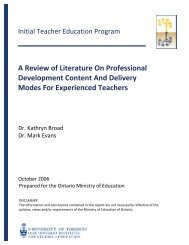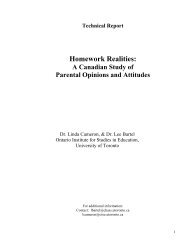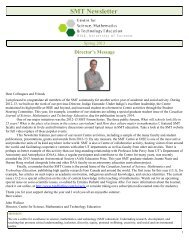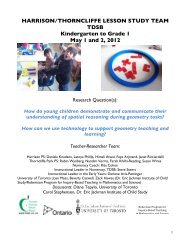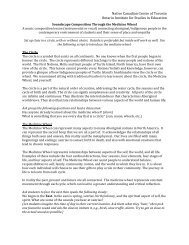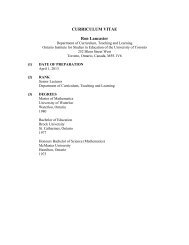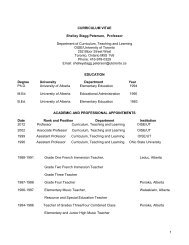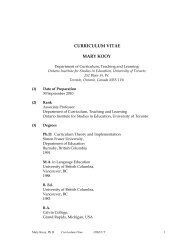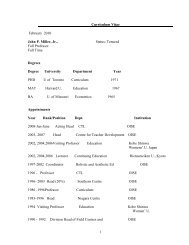The Ontario Curriculum, Grades 9-12 - Ministère de l'éducation ...
The Ontario Curriculum, Grades 9-12 - Ministère de l'éducation ...
The Ontario Curriculum, Grades 9-12 - Ministère de l'éducation ...
You also want an ePaper? Increase the reach of your titles
YUMPU automatically turns print PDFs into web optimized ePapers that Google loves.
D1.2 analyse the conditions (e.g., temperature, pressure, presence of a catalyst) required to<br />
maximize the efficiency of some common natural or industrial chemical reactions (e.g.,<br />
<strong>de</strong>composition, combustion, neutralization), and explain how the improved efficiency of<br />
the reaction contributes to environmental sustainability [AI, C]<br />
Sample issue: Bleaches such as hydrogen peroxi<strong>de</strong> and chlorine are used when fibres are<br />
processed into paper or textiles. Concentrations of these substances can harm the<br />
environment, but if enzymes are ad<strong>de</strong>d to these processes as biocatalysts, fewer<br />
chemicals are nee<strong>de</strong>d, less energy is consumed, and there is less environmental impact.<br />
Sample questions: How can you increase the rate of <strong>de</strong>composition in a home<br />
composter? What can be done to improve the efficiency of an automobile that runs<br />
entirely on fossil fuels? Why is just a very small quantity of catalyst required in industrial<br />
processes? Why is the ozone layer still <strong>de</strong>teriorating <strong>de</strong>spite the banning of<br />
chlorofluorocarbons (CFCs)?<br />
E. Chemical Systems and Equilibrium<br />
E1. Relating Science to Technology, Society, and the Environment<br />
E1.1 analyse the optimal conditions for a specific chemical process related to the principles of<br />
equilibrium that takes place in nature or is used in industry (e.g., the production of sulphuric<br />
acid, electrolyte balance in the human body, sedimentation in water systems) [AI, C]<br />
Sample issue: <strong>The</strong> principle of dynamic equilibrium is used in industrial processes to<br />
maximize the concentration of products and minimize leftover reactants. Industrial<br />
chemists <strong>de</strong>termine i<strong>de</strong>al pressure and temperature conditions, and proper catalysts, so<br />
that fewer materials and less energy are used.<br />
E1.2 assess the impact of chemical equilibrium processes on various biological, biochemical,<br />
and technological systems (e.g., remediation in areas of heavy metal contamination, …)<br />
[AI, C]<br />
F. Electrochemistry<br />
F1. Relating Science to Technology, Society, and the Environment<br />
F1. analyse technologies and processes relating to electrochemistry, and their implications for<br />
society, health and safety, and the environment<br />
F1.1 assess, on the basis of research, the viability of using electrochemical technologies as<br />
alternative sources of energy (e.g., fuel cells for emergency power generation or as power<br />
sources in remote locations), and explain their potential impact on society and the<br />
environment [IP, PR, AI, C]<br />
Sample issue: Hydrogen fuel cells use hydrogen as the fuel and oxygen as the oxidant,<br />
and produce water, rather than environmentally harmful greenhouse gases, as waste.<br />
Although some cars run on such cells, practical problems must be resolved before this<br />
source of energy is commonly used in the transportation sector.<br />
Sample questions: What is the capacity of a standard rechargeable battery before it has to<br />
be recharged? What methods should be used to dispose of <strong>de</strong>pleted batteries? …<br />
F1.2 analyse health and safety issues involving electrochemistry (e.g., corrosion of metal pipes<br />
in drinking water systems) [AI, C]<br />
<strong>12</strong>4 Environmental Education, <strong>Gra<strong>de</strong>s</strong> 9−<strong>12</strong>: Scope and Sequence of Expectations, 2011



